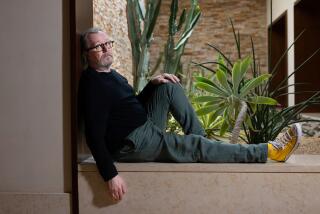The Novelist Who Came in Like a Lion
Tired of all the subterfuge, sleaze and self-serving “spin”? Maybe it’s time to tune in to someone like Wally Lamb, a humble guy of 48 who has spent the last 25 years teaching and can’t imagine a more exciting career. Who is still teaching, even though he’s so rich and famous that he doesn’t have to work anymore.
And who has a fictional population the size of New Jersey constantly prattling in his head.
His good fortune springs from two blockbuster novels he has written: “She’s Come Undone” (Pocket Books, 1992) and “I Know This Much Is True” (ReganBooks, 1998). Both were touted on TV by Oprah Winfrey, propelling them onto bestseller lists. “Undone” has been there 53 weeks; the new book, out since July, has been there 16. Both have been optioned for films.
We checked in on him by phone the other night, to see how he’s handling all this income and fame. He said he was hunched over the kitchen table, in jeans and a T-shirt, frantically stapling syllabuses to give to his college students the next day. After years of teaching high school English, he signed on as an assistant professor of creative writing at the University of Connecticut this semester.
It had been the first day of school for all the Lambs (except the dog). The three kids (7, 13, 17) were doing homework with Chris, Lamb’s wife of 20 years, who teaches first grade. It was late. Lamb was tired--but too polite to cut us off. Besides, unexpected phone calls have been good omens for him.
In 1991, for example, he was on hands and knees removing a wad of gum from the classroom floor when the phone rang and he learned that his first novel, which he’d been working on for nine years, had just been sold.
Publisher Judith Regan, resting after the birth of a child, had picked up the manuscript of “She’s Come Undone” and couldn’t put it down. The book’s tragicomic, overweight heroine Dolores Price--who endures abuse, rape, abortion, infidelity and abandonment before she finds true happiness--was “lovable, hateful, tragic, exasperating--she’s everything we are,” Regan said. “It was a rare gem that came to me already polished.”
(Lamb contends that the polish is not really his doing, that he simply lets the voices inside his head say what they want.)
Picture the joy in the Lamb household that evening when Papa relayed the news of Regan’s call. For years he had struggled out of bed each weekend at 4 a.m. and had written in longhand until the rest of the family awoke; had worked part of each summer at writing workshops in Vermont; had spent winter evenings in local writing groups. And for nine years, Chris--the “most honestly critical fan a writer could have,” Lamb says--had been reading his work-in-progress. Their most fabulous fantasy had been that some day, somehow, the story might find a publisher.
And now it had.
*
With part of the $150,000 advance, Lamb bought the family a Honda, their first air-conditioned car. When the reviews came out, the New York Times called his book “stirring and hilarious”; Time deemed it “funny, touching, deliciously offbeat.”
Other reviewers were amazed that such bull’s-eye insights about womanhood could have been written by a man. One reviewer in the Midwest forgot to check the facts and actually hailed Lamb as “one of a select group of women authors” reshaping ‘90s literature.
(Growing up with two sisters in the house and a bunch of female cousins down the street can give a guy near-perfect female pitch, Lamb explains.)
He became a minor celebrity in his hometown of Norwich, Conn. But he kept his day job. And he started a new novel in his spare time, working on it steadily for the next few years. Along the way, some more lucky phone calls came in.
He was home doing the family laundry and “almost fell into the spin cycle” when he answered the phone one day to find Winfrey on the other end. She was calling just to say she liked “Undone.” In 1997, after Winfrey started a book club on her TV show, she called again to say she’d selected the by-then 5-year-old novel for her viewers to read and discuss. “Undone” zoomed to No. 1 on the bestseller lists; the number of copies in print soared from 4,000 to 3 million.
This was success of a serious sort.
“Surreal is the word I’d use,” Lamb says.
Suddenly, other celebrities he’d never met started calling to congratulate him. Major media types showed up at his door for interviews. Financial consultants counted his assumed millions and phoned to offer investment advice.
His 80-year-old father started wearing “full Oprah regalia” (a T-shirt and hat he’d gotten from the show) and appointed himself unofficial Lamb publicist. Now, when the author visits his parents, who live down the road, they often have a pile of books brought by neighbors for their son to autograph.
Lamb even found one of his own sons leading a group of local kids inside the house to hear “Oprah’s actual voice” on the answering machine cassette. (“I never found out if he was charging them,” the author says with a chuckle.)
What was Lamb’s response to all this?
He checked in briefly with a therapist “to make sure I kept my priorities straight” and started working as a volunteer at the day care center for children of the high school students he was teaching.
The Lambs adopted their now 7-year-old son and moved to a more spacious house very close to the one they’d always lived in. Then his second novel arrived in the stores. “I Know This Much Is True” is an 897-page saga of identical twins born in separate decades, on either side of midnight at the cusp of 1949-50.
One grows up to be a schoolteacher-turned-house painter who is plagued by repressed rage and encyclopedic problems. A partial list of those would include: abusive stepfather, unknown real father, depressed mother, failed marriage to a woman he still adores, the SIDS death of their baby, and a sleazy shoplifting girlfriend obsessed with her own ex-lover. And the heaviest emotional baggage of all: a paranoid schizophrenic twin brother to whom he is forever bound by unrelenting love and guilt.
Again, reviews were mostly excellent. The Washington Post called the new book “astonishing.” Other reviewers likened Lamb to James Joyce, Tolstoy and Dostoevsky. But the pattern of the family’s life, Lamb says, remains basically the same.
He says he is glad success struck him when he was older and reasonably settled, or it might have turned his head. At this point in his life, he is “a husband, father and son first; a teacher second. And writing is somewhere down below that, in third or fourth place,” he said the other night. “I intend to keep it that way.”
Aren’t these odd priorities for a man with so many complicated characters chattering inside his head, begging to be let out? Wouldn’t it be wiser to spend his full time releasing them?
Not at all, the author replied. His characters stem from the life he lives. “Teaching informs the teacher.” And love of family, for him at least, is where creativity begins.
“I Know This Much Is True,” he noted, is a family tale in the most profound sense, a tapestry of emotions and events in which baggage from the family’s past affects the twins’ future. It shows how love, the lack of it, or the perversion of it helps mold character. Lamb says the twins’ lives are filled with hope, pain and humor, like the lives of his own family, and those of the real-life students he has taught for so many years.
He says he is “truly humbled” by the recognition his work has received, that he cares so much about his characters, feels so close to them, that he wants them “to do well in the world.” Interviewers “focus too much on fame and money,” he says. “Really, we have enough. We are not trying to just accumulate more and more. We give a portion of it to worthy local causes.”
More to Read
Sign up for our Book Club newsletter
Get the latest news, events and more from the Los Angeles Times Book Club, and help us get L.A. reading and talking.
You may occasionally receive promotional content from the Los Angeles Times.









